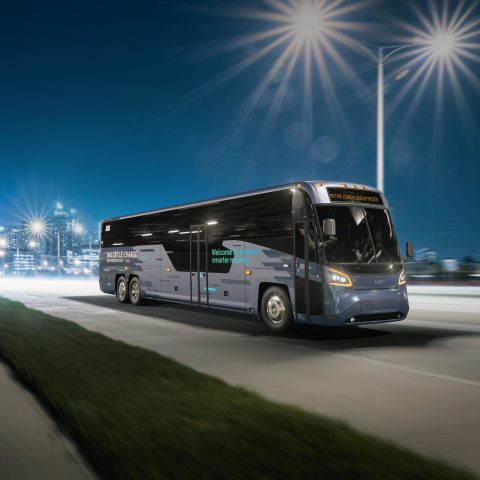“Orders for electric trucks and buses to rise to 54,000 units by 2025” in the US. Our interview with Mike Hynes, CALSTART
The zero emission bus market in the United States is experiencing a remarkable surge, with significant advancements and unprecedented funding opportunities driving the adoption of electric buses. In this interview, Mike Hynes, National Transit Bus Program Manager at CALSTART, sheds light on the latest trends and developments in the industry. From the substantial increase in […]

The zero emission bus market in the United States is experiencing a remarkable surge, with significant advancements and unprecedented funding opportunities driving the adoption of electric buses.
In this interview, Mike Hynes, National Transit Bus Program Manager at CALSTART, sheds light on the latest trends and developments in the industry. From the substantial increase in e-bus registrations to the impact of funding programs and barriers to widespread adoption, from the potential impact of legislative acts to the barriers and opportunities for e-bus adoption, Hynes provides insights into the evolving landscape of zero emission buses in the USA.

IRA funds provide the ability to upgrade manufacturing capabilities, which is vital to address the need to build more buses and key components – batteries in particular. Tax credits included in the IRA are also a key benefit in the commercial vehicle market, as is funding for new programs like the Greenhouse Gas Reduction Fund, which provides grants, loans, and other assistance. Projections from the Environmental Defense Fund (EDF) showed that orders for electric trucks and buses are expected to rise to 54,000 units by 2025
Mike Hynes, National Transit Bus Program Manager, CALSTART
Mike Hynes, CALSTART, on funding for zero emission buses in USA
CALSTART recently released that, in 2022, the US e-bus market experienced a 66% increase, with a total of 5,480 funded, ordered and/or delivered vehicles. Do you have any figures concerning only registrations, in terms of volumes and of comparisons with the past years?
“CALSTART has not endeavored to request registration data from state departments of motor vehicles, though we may do so for future iterations of the Zeroing in on ZEBs report series; we are continually working to improve our data-collection efforts. You can find more information here“.
Your organization also underlined that “historic levels of funding were made available for zero-emission transit projects and paved the way forward for ZEB adoption”. Can you quantify the amount of fundings available and their potential consequences on the market in terms of deployment of zero emission buses?
“With the passage of the Infrastructure Investment and Jobs Act (IIJA), we have seen an enormous influx of funding being made available to support transit agencies as they transition to zero-emission fleets. The Federal Transit Administration’s (FTA’s) Low and No Emissions (Low No) program continues to be the main source of federal funding, via the passage of the IIJA, Low No received $5.25 billion in funding over five years. Since the inception of the Low No program, more than 2,600 zero-emission buses have been funded, and 2022 saw a marked increase in the number of funding applications. With a combined $1.7 billion in funding for fiscal year 2023 projects available from both the Low No and the Bus & Bus Facilities programs, we expect to see continued high demand for these federal funds as transit agencies look to fund their zero-emission projects.
Increased funding has also been made available to federal programs; one such is the Congestion Mitigation and Air Quality Improvement (CMAQ) program, which, via the passage of IIJA, resulted in funding of $13.2 billion for the program. The funding support from the federal government, along with state programs such as California’s Hybrid and Zero-Emission Truck and Bus Voucher Incentive Project (HVIP), is vital in ensuring transit agencies have the necessary financial resources to achieve their zero-emission fleet goals“.
Zero emission school buses, what is going on?
Let’s focus on zero emission school buses. According to forecasts, 27,000 units are to be built in ten years in the US. Do you agree with such expectations? Isn’t upfront price a barrier, and which financial tools are used (or should be used) in order to make the purchase of zero emission school buses easier?
“CALSTART, in partnership with the World Resources Institute, recently published a white paper on the electric school bus market that included an assessment of manufacturing capacity and readiness. Based on our findings, the influx in electric school bus incentives, paired with the increase in state legislation adoption mandates, could fuel production numbers in this area. Right now, initial purchase price is a concern for many looking to adopt electric school buses, but there are many options out there to bring those costs down. School districts and other operators should be considering all funding and financing options available to them; these could be federal, state, and local incentive programs (grants, rebates, vouchers, etc.) but also included are more unique financing options such as As-a-Service contracts or Green Bank financing. Those interested should check out WRI’s Funding and Financing Options article for more information. We are seeing a trend from states and utilities, since the release EPA’s Clean School Bus Program, to establish companion or complimentary incentive programs, so expect to see even more funding options in the next few years to help with electric school bus adoption“.
Which effects do you expect from the IRA on the evolution of the zero emission bus market?
“Between the passage of the Inflation Reduction Act (IRA) and the Infrastructure Investment and Jobs Act (IIJA), we have additional tools to help achieve the transition to zero-emission transit buses. IRA funds provide the ability to upgrade manufacturing capabilities, which is vital to address the need to build more buses and key components – batteries in particular. Tax credits included in the IRA are also a key benefit in the commercial vehicle market, as is funding for new programs like the Greenhouse Gas Reduction Fund, which provides grants, loans, and other assistance. Projections from the Environmental Defense Fund (EDF) showed that orders for electric trucks and buses are expected to rise to 54,000 units by 2025. With federal funding available, as well as state funding and associated initiaves, transit agencies are in a position to move towards achieving their zero-emission goals. Considering these factors, it is anticipated that the bus market will respond to the increase in demand“.
The Federal Transit Administration’s (FTA’s) Low and No Emissions (Low No) program continues to be the main source of federal funding, via the passage of the IIJA, Low No received $5.25 billion in funding over five years. Since the inception of the Low No program, more than 2,600 zero-emission buses have been funded, and 2022 saw a marked increase in the number of funding applications. With a combined $1.7 billion in funding for fiscal year 2023 projects available from both the Low No and the Bus & Bus Facilities programs, we expect to see continued high demand for these federal funds as transit agencies look to fund their zero-emission projects
Mike Hynes, National Transit Bus Program Manager, CALSTART

Where are we standing in terms of TCO between electric buses and traditional buses, also considering supply chain constraints and raw materials price growing?
“The initial capital cost of a battery-electric bus remains higher than that of a comparable diesel bus, but subsequent savings in terms of fuel and maintenance costs significantly lower the total cost of ownership; lower, in fact, than those of a conventional diesel bus. Ultimately, of course, the total cost of ownership includes more than just purchase price. Transit agencies must also consider fleet, facilities, fuel and maintenance costs, as well as potential incremental costs such as operator and maintenance personnel training. The FTA Low No program has sought to address these incremental costs by requiring that 5% of an award for any project related to zero-emission vehicles be spent on workforce development and training as outlined in the awardee’s fleet transition plan“.
What are at the moment, according to your view, the main barriers to e-bus adoption in USA?
“Certainly, the initial upfront cost remains a factor. The increased cost makes it even more important that key programs like Low No have funding available to help offset the initial cost. As the zero-emission bus market continues to evolve, we anticipate that vehicle costs will decline as manufacturers streamline their processes and the supply chain stabilizes post-COVID19.
There are often significant knowledge gaps when working towards implementing zero-emission transit projects. Whereas a conversation about adding conventional-fuel buses may not extend outside a transit agency, the adoption of zero-emission buses requires collaboration between the transit agency, utility providers, and quite often local jurisdictions. Transit agencies need to fully understand the implementation of zero-emission vehicles, utility providers must consider the increased power demands, and local jurisdictions often become involved in infrastructure and policy discussions that they may not fully understand. Taking steps to understand all the key parameters is vital. Developing a fleet transition plan, required for federal grant programs like Low No, is imperative to ensure that all the necessary components of making the transition to zero-emission have been addressed.
Finally, infrastructure related to zero-emission buses can be a challenge. Transit agencies must consider how they will integrate the necessary charging infrastructure, such as electrical transformers and switch gear. Those choosing to utilize hydrogen fuel-cell vehicles need to account for not only how they will be supplied the hydrogen fuel, but also where they will store it, for example. Transit agencies may or may not have adequate existing space to add the necessary infrastructure to support either a battery-electric or fuel-cell fleet. Careful planning is necessary to determine if existing facilities need to be upgraded or if an agency needs to find new locations to support their zero-emission fleet“.
May you outline which major trends do you see in the US concerning charging strategies and the choice for hydrogen or battery-electric technology?
“With vehicle range a continuing concern for many transit agencies, and as the hydrogen fuel-cell vehicle market grows, it is expected that interest in fuel-cell vehicles will increase. Ultimately, transit agencies need to develop a fleet transition plan and take a holistic approach to their service, determining the zero-emission technology that best fits their needs. For some agencies that may be a fully battery-electric or fuel-cell fleet, while for others it may be a combination of fuel types, particularly for transit systems that operate longer-range commuter services“.







